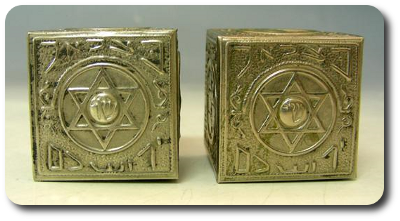
April 2011, Issue 15
Dollhouse Tourism, Israel
Page 78
 micrography as a kind of internal art creating small samples of micrography within Bibles, ornamenting such scriptures as the Psalms.
micrography as a kind of internal art creating small samples of micrography within Bibles, ornamenting such scriptures as the Psalms.
Scribes in ancient Israel and Egypt were trained to write in very small letters, especially to create the scrolls that go inside a mezuzah or to write notes of commentary in the margins of Hebrew Bibles, and so used their specialized ability to create an original art form.
Rare Bezalel silver miniature tefillin (phylacteries) cases, Jerusalem, 1930's, Judaica. Each case is decorated with three chased depictions of David's Tower, Rachel's Tomb, Yad Avshalom and the Western Wall. The top is marked in Hebrew Bezalel Yerushalem, centered by a Star of David (Magen David) while one is inscribed in Hebrew Shin Yud (Shel Yad - For the hand) and the other is inscribed in Hebrew Shin Resh (Shel Rosh - For the head). www.pasarel-art.comMicrography spread from the scribes of the Near East to the Jewish communities of the Diaspora--to the Sephardic communities of Spain and Portugal, as well as to the Ashkenazic communities of Eastern Europe. It was an art form taught from one scribe to another, each scribe adding his own innovation and mark, until by the 17th century, micrography was used to embellish all kinds of Judaica: ketubot, omer calendars (used to count the days between Passover and Shavuot, a period known as the omer), decorations for the Sukkah, and wall-hangings for the home.
As the art of micrography continues to grow today throughout the Jewish world, it is still most often sacred words used to create the visual patterns or designs.
The Holy Land of Israel is filled with artistic diversity and rich history just waiting to be explored.
Next stop Mexico!
Custom Dolls, Houses & Miniatures / CDHM







